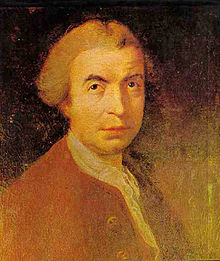This article needs additional citations for verification. (August 2022) |
Roger Joseph Boscovich | |
|---|---|
 Portrait by Robert Edge Pine, London, 1760. | |
| Born | Ruđer Josip Bošković 18 May 1711 |
| Died | 13 February 1787 (aged 75) |
| Citizenship | Republic of Ragusa |
| Alma mater | Collegio Romano[1] |
| Known for | Precursor of the atomic theory Founder of Brera Observatory |
| Awards | ForMemRS (1761) |
| Scientific career | |
| Fields | Theology, physics, astronomy, mathematics, natural philosophy, diplomacy, poetry |
| Institutions | Brera Observatory University of Pavia |
Roger Joseph Boscovich SJ (Croatian: Ruđer Josip Bošković, pronounced [rûd͡ʑer jǒsip bôʃkoʋit͡ɕ]; Italian: Ruggiero Giuseppe Boscovich;[2] Latin: Rogerius (Iosephus) Boscovicius;[3] 18 May 1711 – 13 February 1787) was a physicist, astronomer, mathematician, philosopher, diplomat, poet, theologian, Jesuit priest, and a polymath from the Republic of Ragusa.[4] He studied and lived in Italy and France where he also published many of his works.[5]
Boscovich produced a precursor of atomic theory and made many contributions to astronomy, including the first geometric procedure for determining the equator of a rotating planet from three observations of a surface feature and for computing the orbit of a planet from three observations of its position. In 1753 he also discovered the absence of an atmosphere on the Moon.[6]
- ^ The successor institution to the Collegio Romano is the Pontifical Gregorian University.
- ^ "La firma autografa (The original Boscovich's autograph)". edizionenazionaleboscovich.it. Retrieved 12 January 2015.
- ^ Gerardus Heerkens, Notabilium libri II, Groningae, 1765, p. 61: "Dalmata erat Boscovicius, Ragusâ oriundus".
- ^ Biography: Roger Joseph Boscovich, S.J., Fairchild University website.Archived 27 November 2010 at the Wayback Machine
- ^ James, I. (2004). Remarkable Physicists: From Galileo to Yukawa. Cambridge University Press. p. 47. ISBN 9780521017060.
- ^ Энциклопедия для детей (астрономия). Москва: Аванта+. 1998. ISBN 978-5-89501-016-7.